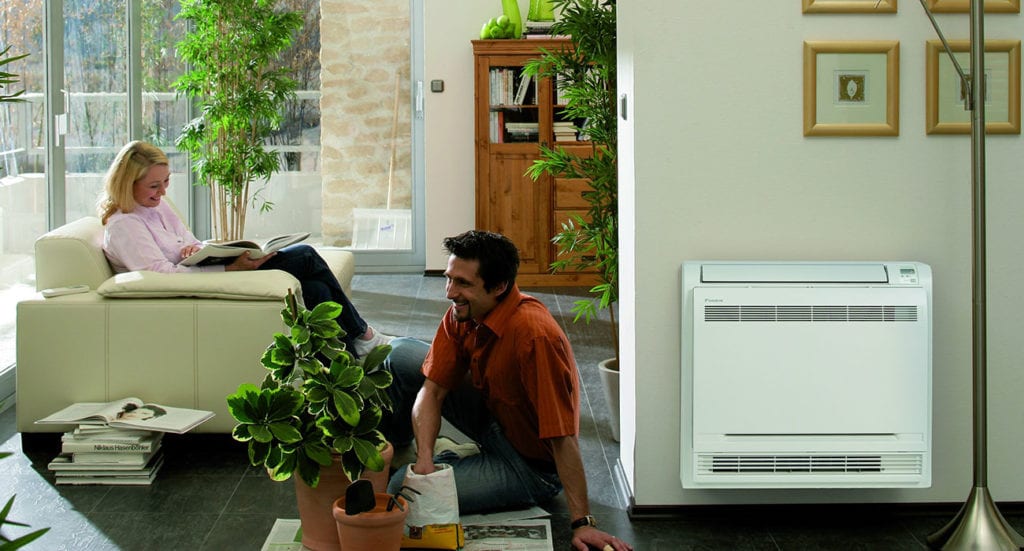With warmer months approaching, you’ll want to have some form of cooling system in your home. From ceiling fans and window units to ductless mini-splits and forced air, there are many ways to keep cool throughout the summer. Continue reading to learn the best way to beat the heat that will fit your budget and your home.
Standing and Ceiling Fans
Perhaps one of the most well-known ways to stay cool is with standing and ceiling fans. While a fan can help a person to cool down, it doesn’t actually cool a room or house. The breeze disrupts the stagnant layer of air that surrounds a person’s body, helping them to feel cooler. However, the temperature in the room and house will stay the same. Considering this, fans can be a great addition to homes with an existing air conditioning system, creating a cool and comfortable breeze.
Pro tip: Set your ceiling fan to run counter-clockwise in the summer so it pushes the air straight down, creating a cooling effect.

Taking Advantage of Your Windows
This one may seem obvious, but a good way to stay cool throughout the night is by opening up your windows during the night to create a more comfortable sleeping temperature. While the lower night temperatures can help keep your house cool, you’ll want to shut them during the day to keep the heat out, along with closing blinds to keep the natural sunlight from warming your home. Using your windows combined with a fan could be an easy and cost-effective way to stay cool.
Portable and Window Air Conditioning Units
A seemingly inexpensive way to cool your home is through a portable or window air conditioning unit. These are a step up from just a fan, as they actually cool a room by using cooling coils and fans to produce the desired room temperature. However, the unit will only cool the areas of a room closest to where it is located, so if you’re looking to cool down your entire house, this option can quickly become costly and inefficient compared to a traditional central AC system. Additionally, these window or portable units tend to have poor air filtration, which can lead to health risks or worsen preexisting conditions, so you will want to be mindful of any necessary precautions you may want to take to improve your indoor air quality.

Ductless Mini-Split
A ductless mini-split system is a heat pump and air conditioning unit that is mounted to the wall indoors, and works with an outside compressor. Unlike window units, only a small hole needs to be drilled to reach the outside components, making it safer and less vulnerable to leaks. Here are some of the pros of a mini-split system:
- They’re energy efficient – Since they’re ductless, no air can get lost through leaks; that means the system doesn’t have to work as hard, creating an energy-efficient system that saves money.
- Easy installation – In order to install a central air system, floors, walls, and ceilings are typically cut open to insert the ductwork. With a mini-split, it’s an easy one-day process where the unit is mounted on an existing wall.
- They can be zoned – Some models can have as many as four indoor handling units, with each one having its own thermostat. This makes it possible to set rooms at different temperatures, and shut other rooms off when unused, saving energy.
- Ideal for home additions, or homes with no existing ductwork – If you’ve added on to your home, or purchased a new home with no existing ductwork, a ductless mini-split will be an easier and more cost-effective way to heat your home.
A ductless mini-split could be the perfect way to cool your home; however, they typically cost around the same as, or more than, traditional forced air equipment if a home has existing ductwork. Continue reading to compare the benefits of a central air system to see which is right for your home.
Central Air Conditioning
When you think of air conditioning in a home, it is typically forced or central air, which is cool air being pushed through the house via ductwork and fans. Here are some of the reasons you may want to consider central air:
- Lower Initial Cost – If you have pre-existing ductwork, getting a forced air system installed is typically lower than a ductless mini-split.
- Size and Range – Because the ducts go to each room, central air conditioning is better at handling larger homes that need consistent heating and cooling.
- Integration with Air Quality Products – Indoor air quality is extremely important to the health of both the people in the home, and the equipment. There are more and better options for air filtration in a central air system, and humidifiers, dehumidifiers and air purifiers all integrate well with a ducted home system.
- More Options – There are simply more options out there when it comes to central systems, like air conditioners, heat pumps and furnaces, making it easier to find the perfect match for your home.

While central air is a great way to cool your home, it does require maintenance and could be less energy-efficient if you have leaky ducts. However, these can both be mitigated with routine maintenance and professional products like Aeroseal.
At Bears Home Solutions, we have skilled and knowledgeable professionals that can help you find the best way to keep your home cool this summer. To learn more, call to speak to one of our Comfort Advisors or request an appointment today.



